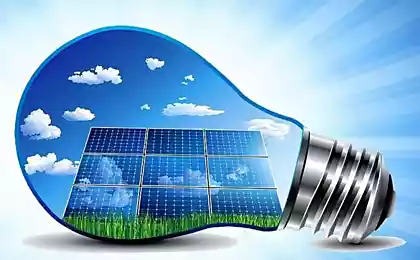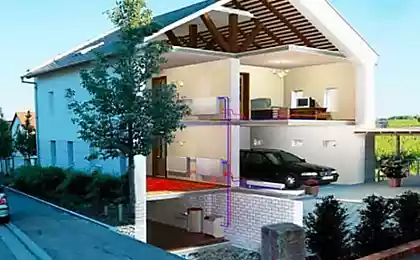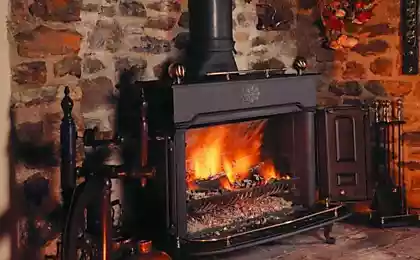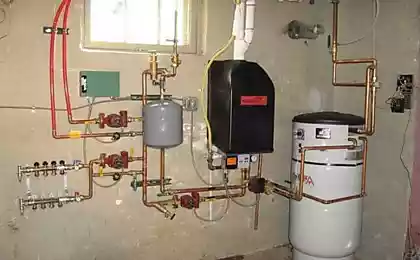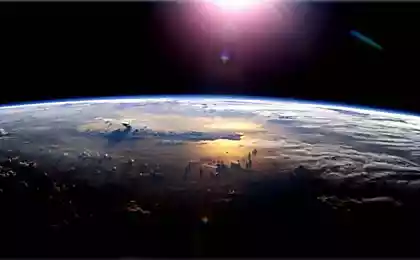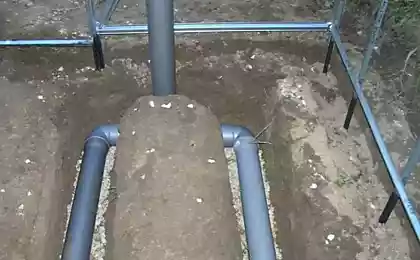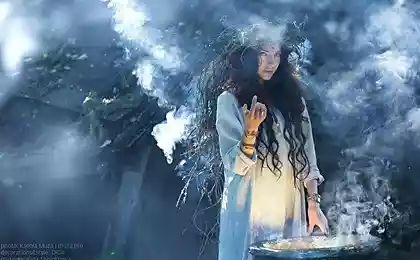828
Do yourself solar heating of private homes — 8 options
It is in the 19th century the house was heated by wood stoves and a 20-m – gas-fired boilers. It is now the 21st century is the century of information technologies, high energy prices and to combat the "greenhouse effect". Now solar panels sell cheaper than $ 1 per W of power, although in 1977 1W sold for an average of over 77 $ (easy to remember: "four sevens"). And all sorts of solar collectors (e.g., vacuum tubes) are also significantly cheaper.
And do not think that solar heating of homes develops only in Denmark, Germany, Sweden or Canada. For example, you can see videos where people in Odessa, he made 18 sq m flat solar collectors, and they have the second season provide heat for heating his home.
SUBSCRIBE to OUR youtube channel that allows you to watch online, download from YouTube free video about the recovery, the rejuvenation of man. Love for others and ourselves, as the feeling of high vibrations — an important factor for improvement .
Put LIKES and share with your FRIENDS!
www.youtube.com/channel/UCXd71u0w04qcwk32c8kY2BA/videos
1) the "Minimal" option:
Many people think that it is possible to buy a small number of solar collectors (up to 10-20 m), and they will solve all their problems with heating the house. And besides all of these collectors can be placed on the roof, i.e. should get something like the following photo:

Unfortunately, this is not enough for full heating of the house (although it is several times more than would be needed to supply hot water to showers and washbasins). For example, 10 square metres of collectors will be issued on a Sunny day only 3-5 kW heating power, which is enough for heating about 50 sq m of space during the cold weather. But, obviously, the sun's heat will not be a night and on cloudy days, ie more than 95% of the time from November to February.
In October and March-April, so the house is already warm is impossible, because during the sun and it heats the room through the window, and often it comes even before that vents have to be open, that was not so hot. And at the same time of night the house is heated very necessary as the temperature outside drops to zero and below. A way out of this situation is the heat accumulator: this is a tank of water (500 liters of water per 8-12 sq. m collectors), which on a Sunny day heats up the collectors, to the next night to give it to heat the radiators.
The economic implications of using option number 1 is, then, if the cost of solar collectors is less than 50 EUR per sq. m. In this case, you can keep within 300-1000 EUR for the whole system (10-20 sq. m of collectors, heat storage 500-1000 liter, pumps, pipes, heat exchangers, automation), and give it the following:
The saving of about 80 cubic meters of gas in November-February (this inclusion for 20-25 Sunny days during this period)
The saving of about 120 cubic meters of gas in the second half of October and in March and the first half of April. But this is only if the thermal battery
— Full heating of the house in early October and in late April and early March. The nights at this time still cold, and therefore it is possible to heat the house during these moments (heat from the sun is free anyway), not to go in the sweater not to freeze at night.
— Complete (with great abundance) domestic hot water from may to September. Excess hot water is so much that it could be distributed to neighbors
Obviously, option # 1 is very costly vacuum tubes and flat collectors, which are sold in shops for EUR 150-300 per sq. m. Thus, we still need to do flat-plate collectors, and in Internet you can find (with great difficulty) design of flat-plate collectors with EUR 30-50 / sq m of component costs. But not every self-made collector will be able to work effectively in the winter. Therefore, we cannot make serious decisions without experimentation or expert advice.
On the location of the collectors on the roof is better not to think: they mount there automatically increases their value by 10-30 EUR / sq m compared to the location on the earth. And serve them there will be very difficult, especially if you choose an unreliable design of the manifold.
The heat accumulator (500-1000 liter of water) is also better to make yourself because buying such a shop will cost about 1000 EUR. And anyway, better to do yourself, because the payment of mercenaries will not allow to meet the goal of "300-1000 EUR for the whole system".
But it would be better if you use a very cheap solar collectors with price levels, "EUR 10-20 / sqm". An example of such header:
SUBSCRIBE to OUR youtube channel that allows you to watch online, download from YouTube free video about the recovery, the rejuvenation of man. Love for others and ourselves, as the feeling of high vibrations — an important factor for improvement .
Put LIKES and share with your FRIENDS!
www.youtube.com/channel/UCXd71u0w04qcwk32c8kY2BA/videos
In this case, the owner of a private house it would be difficult to make the next choice. On the one hand, he can invest 300-700 EUR in the solar station with 10-20 sq meters of collectors. But on the other hand, the insulation of the walls (expanded polystyrene) or replacement of the Windows will require the same 300-700 EUR. And the effect of these investments is approximately the same for all these variants (reduction of gas consumption by 10-15 %). In this case, you will have to make a choice based on the following features:
— House warming is "made and forgot", while the solar plant would require supervision and maintenance.
— Solar station will require land for its location: 15 sq. m collectors will require a plot of 2 m x 10 m, free from shadows.
The solar station will provide many free summer heat. It can be used for the domestic hot water production, electricity production or other purposes, as described in option # 2.
And if the house is already warm walls and new Windows, the choice will be gone: you need to build the solar station.
Option number 1 is the only one that doesn't require a lot of land for solar power plants. In addition, it is the initial stage for the transition to other options (If we want to build a large solar plants, you should start all the same with a small station).
2) solar station with extra winter warmth:
This option is not suitable for everyone a private home.
For example, it may be a house with an outdoor pool. For example, for a 50-ton outdoor pool recommend 25-30 sq. m of solar collectors (recommended area of solar collectors is approximately equal to 70-100 % of the area of the outdoor pool). And it turns out that in the may-September heat collectors is for heating swimming pool water, and in October-April heat manifolds is unnecessary, so it can be aimed at heating the house.
The pool may be the owner of the adjacent plot. In this case, you can sell him the summer heat (for heating pipes with a heat exchanger and a heat meter), and payment of heat will pay for the solar station for several years (and as an added bonus – a free winter warmth to heat her home).
Option # 2 is also good if next to (no further than 50-100 m) will be another large consumer of summer warmth: recreation, hotel, factory, etc.
You can sell hot water (on water meter), arranged on the edge of your shower area for a plant or agricultural enterprise. Outside of his plot to organize a place cleaning of containers, animals, etc.
Also, the summer heat may be necessary for the business owner, for example, lumber drying: for drying 100 cubic meters of wood per season required about 20 000 kWh of heat than can handle (for may-September), about 100 sq. m of collectors. You can custom build a dryer to make money on orders from sawmills. Or you can persuade a friend to put a drying on his land.
It is possible to dry the solid fuel for your home. For example, to dry 10 wet tons Stipa (up to 5 tons of dry, then to make her pellets), you need to spend about 3.5 kWh of heat for the season (about 20 sq. m collectors).
Generally, you can find a lot of other use summer heat ("he who seeks will always find"). The main thing that it was such use is to warm may-September was the most popular, and the heat Nov-March for this purpose was unnecessary.
If such a solar station must have 30-100 sq. m of collectors, the house will receive warm, which will cover 20-50 % of its heating requirements.
3) Option "2 sq m home is approximately 1 square meter of solar collector:
This option will require 1-3 acres of land. For example, it may be the vegetable garden, and he is not lost, because between the rows of solar collectors is enough space for growing potatoes and other crops, and in the shadow of solar collectors you can try to plant woodland strawberries or some flowers can not tolerate the sun (there's also growing very well green grass, such as lawns). In addition, collectors can remove for the period of may-September as they are at this time not needed, but such deletion may be to extend their service life. If the earth isn't present, you can negotiate with the neighbors, paying them an excess of solar heat in may-September.
Thermal battery need a large (tank with a few tons of water), and it needs to be surrounded by a thick insulation (20-40 cm), to store heat for several days or weeks. To reduce the thickness of its insulation makes sense if the battery is installed in the basement, a greenhouse or a room that requires heat; in this case the heat leakage from the battery are even useful, and he, like, is an additional "radiator", is equivalent to a cast iron radiator with 10-20 sections. For every 1 square meter of collectors is required 60-90 liters of the heat accumulator. When discharging (i.e. cooling from 80-100 to 40-60 grad degrees), each 1 tons of water battery released heat is equivalent to burning of 5-7 cubic meters of gas. In the process of producing the battery, it will cost from 100-200 EUR / tonne (if welding of steel sheet) to 20-40 EUR / tonne, if it is of the type shown in the video:
SUBSCRIBE to OUR youtube channel that allows you to watch online, download from YouTube free video about the recovery, the rejuvenation of man. Love for others and ourselves, as the feeling of high vibrations — an important factor for improvement .
Put LIKES and share with your FRIENDS!
www.youtube.com/channel/UCXd71u0w04qcwk32c8kY2BA/videos
Thus, option # 3 assumes solar station, consisting of 1-3 rows of the type shown in the following photo:
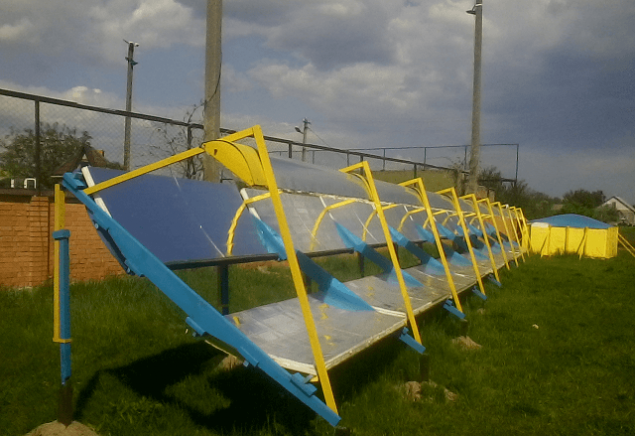
The cost of materials for each such series (it has a 29 square metres of mirrors) – from 250 to 300 EUR. The cost of the other elements of the solar plant described in the video:
SUBSCRIBE to OUR youtube channel that allows you to watch online, download from YouTube free video about the recovery, the rejuvenation of man. Love for others and ourselves, as the feeling of high vibrations — an important factor for improvement .
Put LIKES and share with your FRIENDS!
www.youtube.com/channel/UCXd71u0w04qcwk32c8kY2BA/videos
It is obvious that the closer the station to the house is, the cheaper it will cost. In General, the costs of solar plants are placed in the 400-1200 EUR (subject to its self-production), and it gives the following (on example of station with 60 square metres of mirrors):
— The heating of the house will receive the equivalent of 600-800 cubic meters of gas: solar station (in Central Ukraine) will fully heat it in October and April, and close 50-80% of the heating needs of March and will heat the house on Sunny periods Nov-Feb
— Will also be equivalent to 100-200 cubic meters of gas for cold nights before the heating season and after it: no need to freeze, saving gas
— Will also be 100-200 cubic meters of gas heat leakage from the thermal battery that can be used for heating. But if a battery will stand outside, this heat will be lost (although you might think to round up his greenhouse or orangery)
Solar heat can also be used for hot water house in may-September. You can save about 100 EUR to the cost of traditional hot water source (boiler or gas heater): that will not be necessary if connection of the station in a certain way
— In addition, the station can produce a lot of heat in may-September (equivalent to about 1,000 cubic meters of gas). Where it is possible to do – see No. 2, 4, 8
4) Solar power plant for electricity and heat:
Five ways of generating electricity solar collectors described in my 2-minute video:
SUBSCRIBE to OUR youtube channel that allows you to watch online, download from YouTube free video about the recovery, the rejuvenation of man. Love for others and ourselves, as the feeling of high vibrations — an important factor for improvement .
Put LIKES and share with your FRIENDS!
www.youtube.com/channel/UCXd71u0w04qcwk32c8kY2BA/videos
This is a "steam turbine", "focus light on solar cells", "Peltier elements", "Rankin cycle", "ORC". High efficiency should not count for the production of 1 kWh of electricity will need to spend 10-30 kWh of heat. If the goal is to make 1000 kWh of electricity per year, will require a solar plant of 100 square meters of mirrors. It can be estimated that the cost of such stations (1000-1500 EUR) turns out to be cheaper than solar panels to produce the same amount of electricity (about 10 sq m of solar panels and their mounting, inverters and other equipment). But:
— There's an additional bonus: 100 sq m of mirrors free will give about 1000 cubic meters of gas for home heating and hot water (ie the production of electricity will be sent to only the heat that will be unnecessary for heating or hot water)
— Ways "Peltier elements", "Rankin cycle" and "ORC" to produce electricity not only during sunshine and night, in non-solar days, etc., since they work on heat from the heat accumulator
— Practical implementation of any of those five ways can be good business with great prospects
But to realize this all can only a person well versed in physics. If such a person in the circle of acquaintances no, better to forget about option # 4.
5) the Option of "seasonal thermal battery" for a 100 % solar home heating:
Many people like the beauty of the following ideas: summer heat solar collectors accumulate in a huge thermal battery, and then use this heat for heating the house in winter. This idea is called "Seasonal thermal storage". You can dial these words in Google and see the many different technical solutions. But, unfortunately, they are all very far from the financial capacity of ordinary Ukrainians. For example, very often there is proposed to use as a battery array of excavation under the house, but forget to tell you how to do it cheaply and how to slow down the leakage of heat that way from the collectors. And do not say how all this can be implemented in the case of already built homes, and conventional homes of average Ukrainians: with the usual radiators (not "warm floors"), with poor insulation and no need of the peculiarities of the structure of the earth.
However, option # 5 technically feasible now. But his economic sense is very dubious: either the battery is expensive, or heat leaks from it will be so large that you have to put a lot of solar collectors. Cost all of this will be about the same as the full cost of installing heat pump (tens of thousands EUR), but it will still be a real energy savings because the heat pump consumes vast amounts of electricity. But "seasonal thermal storage" is still not "hyped" technology, and therefore, the Ukrainians prefer to spend money on heat pumps.
Economically interesting option number 5 would be only if someone once proposed the idea to reduce the cost of thermal batteries to 3-5 EUR / cu. m Then they will be beneficial to use together with solar collectors is not more expensive than 30-50 EUR.
6) the "for 1 sq. m house is about 2 sq. m solar collector":
This is a big station, even by European standards: 120-300 sq. m of solar collectors. And heat storage need is large – of the order of 10-30 tons of water (80-100 liters of water per 1 sq. m collector); such a big structure you can position it just on the street.
This station is gonna take home 50-70 % of its heating requirements and will be fully heated until about mid-November and from mid February. But the gas boiler is still needed because December and January are cold months, and the non-solar heat solar plant will be able to cover only 30-50 % of the needs at this time.
However, some owners can try to live comfortably and in such conditions, taking the example of some of our rural residents or owners of the aristocratic mansions in Europe: during the cold periods they limit your living space with multiple rooms (of course, avoiding excessive overcooling other rooms). If you do so, it is possible to completely abandon the traditional boilers, which gives several advantages:
— The house is very secure as traditional boilers often starting fires or gas leaks, poison people with carbon monoxide, explode (what I like to do solid fuel boilers), and also serve as a constant source of wood debris and other annoyances
— The value of the home reduced by several thousand EUR: the price of the boiler and its connections, several sq m boiler room, chimney
— No need to spend money on building connection to gas line (stove can be electric)
To the cost of this largest solar power station was within 2-3 thousand EUR, solar collectors should be cheaper 10 EUR / sqm, and thermal batteries – cheaper 20-30 EUR per ton of water. It is interesting that such costs will be significantly less than the savings that can be obtained from the above-described effect of the abandonment of traditional boiler.
Land for such a station will need a lot: 5-10 acres. Therefore, approximately half of Ukrainian houses option # 6 will not be available. It's good to be a villager: there are large vegetable gardens. In addition, the new suburbs usually have a lot of vacant lots where you can position such a solar station. Perfect case for option No. 6: remote homes and towns: to the gas line to connect to very expensive, and the vacant land around very much.
Interestingly, these solar plants have a large excess solar heat to early November and from late February. Therefore, with them you can put a greenhouse or think, to sell this excess heat for heating neighbors.
For those interested:
There is a misconception that if the number of collectors increase in N times, then the gas savings is increased N times, too. But this rule only works with small numbers of collectors (under option No. 1). The following table shows what happens during the transition from option number 3 (this is the penultimate column of the table) to option No. 6 (last column) for example, a house in the Central regions of Ukraine:
The heating demand of a conventional house
Heat production of 50 square meters of collectors
Heat production of 200 square meters of collectors
January
3 438 kWh
376 kWh
1 504 kWh
February
2 992
695
2 780
March
2 225
1 305
5 220
April
596
1 674
6 696
May
-
2 211
8 844
June
-
2 132
8 528
July
-
2 341
9 364
August
-
2 336
9 344
September
-
2 132
8 528
October
735
1 362
5 448
November
1 955
473
1 892
December
3 059
262
1 048
The total for the year
15 000 kW-hour (2000 cubic meters)
17 299 kWh
69196 kWh
You can see that if 50 sq m of sewers cover 25% of the heating needs at home, by increasing their number 4 times still 100 % of the heating does not work: in December and January the sun's heat is clearly not enough. So you need to choose: either to drown in the time a traditional boiler, or to reduce the heated area of the house.
7) Economically feasible option for a 100 % solar home heating:
Above mentioned, option # 5 though reaches 100 % heating, but not worth the money spent on it (many times cost-effective to heat with gas or wood). It is much cheaper to reach 100 % of the heating, following the path of increasing the number as cheap solar collectors. In this case, the solar station as follows:
First, you need a large heat accumulators for storing the non-solar heat for 15-30 days. This is 40-100 tons of water, and therefore, it is desirable that they were cheaper 15-20 EUR / ton.
Secondly, you need 200-500 sq m of solar collectors, for the location which need 7-20 acres of land. But more than half of this land will be required for two months only: there are solar collectors will be placed at the end of November and removed in early February. Options of land for the temporary installation of such collectors can be quite a lot: it could be the neighbor's garden, undeveloped land, water meadow, agricultural field, any vacant lot, etc. it is Obvious that collectors should be very cheap (5-8 EUR / sq m). Any claims to their appearance it is better to forget: cheap is beautiful. The main thing that they worked effectively, did not attract thieves or vandals, and easily assembled and disassembled.
In General, only about 50 sq. m collectors will have to stand the entire heating season, which will require only 1-2 acres of land. Other collectors will be gradually completed throughout November and depart in February-March.
In the southern regions winters are more Sunny, and so there is the cost of such heating will be in the range of 3-4 thousand EUR. In the Central and Western regions can all be profitable only if the savings account due to the lack of the traditional boiler (ie the price of the boiler and its connections, the cost of the flue and area of the house, a boiler, the cost of connecting the house to gas).
8) is Very cost-effective variant with 100 % solar home heating:
This is an option for those who want to give a complete solar heating their home and wisely invest 5-15 thousand EUR of investment.
This is a very large station, for example, 400 square meters of collectors (on 12 acres of land) in the southern regions or 1000 sq m (40 acres) in the Northern or Western Ukraine. And this station needs to be connected to several private homes. It turns out that something that can be called the "solar boiler": this is the micro analogue of the urban centralized heating.
If such a "boiler room" will be connected to at least 3-5 houses, there is a possibility of 100% solar heating of one of these houses. Of course, it will be the house of the owner "the boiler room"; it will go all solar heat in December and January. Other subscribers will be getting the heat the "boiler" in October-November and February-April, paying it on the heat meter.
If competently to do business, the cost of the construction of a "solar boiler" will be repaid in 3-5 years, and the prospects for business development it is easy to see the construction of hundreds or thousand of these "boiler rooms" in your area or across the country.
The economy of a "solar boiler" is as follows (all excluding VAT, for example, 400 square meters of collectors at home in the Odessa region):
"Solar boiler" will require 5 600 EUR of investments in the following:
— 3200 EUR per 400 sq. m collectors (for 8 EUR / sq. m)
— 800 EUR for 40 tons of heat accumulators (20 EUR / t)
— EUR 600 for 100-200 meters thermal routes to 2-4 callers
— EUR 600 for installation (those 2-4 subscribers) heat meters and heat exchangers (to transfer heat from the dirty water "boiler" in the clean water of the heating system of the houses of subscribers)
— 400 EUR the cost of connecting to home "master boiler" and the other station equipment (pumps and a few small things)
During the heating period in the Odessa region (November-March) "boiler" will generate 40 million kW-h of heat energy (100 kWh per square meter collector), which is consumed as follows:
— 15 thousand kilowatt-hour – home heating "master"
— 15 thousand kWh sales heat the 2-4 subscribers in November and January-March
— 10 thousand kW-hour thermal leakage from the heat accumulator and heat
The sale of these 15 thousand kWh the 2-4 neighbours (for 2 cents / kWh = equivalent gas at 3.5 UAH / cubic m. without VAT) will give 700 EUR of annual revenue. That's not counting the free home heating "master boiler". The result is not bad, but for a rapid return needed to sell heat generated by the station in April and October, and it is 104 thousand kWh (260 kWh per square meter of collector). If you sell at least 70 million kW-hour (1.5 cents / kW-hour = 40% of the price of gas for commercial enterprises), it will be additional annual revenues of 1050 EUR. Thus, the annual profit of the "solar boiler" will be about 1300 EUR (revenue subtracted about 500 EUR annual operational costs of the "boiler room": replacement of parts, electricity, etc.), i.e. the investments will pay off in about 4 years, and the house will be heated for free.
December will be the most critical of the sun for a month, when 400 square metres of collectors will produce only 3840 kWh of heat (9,6 kWh / sq. m) when the heating need of the house of 3,200 kWh.
40 tons of the heat accumulator store 1400 kWh at discharge from 90 deg to 55 deg with losses of 14 %; a 2-week supply of heat for heating the house in December. published
Source: solarpanels.com.ua/articles/delaem-sami-8-variantov-solnechnogo-otopleniya-chastnogo-doma/
And do not think that solar heating of homes develops only in Denmark, Germany, Sweden or Canada. For example, you can see videos where people in Odessa, he made 18 sq m flat solar collectors, and they have the second season provide heat for heating his home.
SUBSCRIBE to OUR youtube channel that allows you to watch online, download from YouTube free video about the recovery, the rejuvenation of man. Love for others and ourselves, as the feeling of high vibrations — an important factor for improvement .
Put LIKES and share with your FRIENDS!
www.youtube.com/channel/UCXd71u0w04qcwk32c8kY2BA/videos
1) the "Minimal" option:
Many people think that it is possible to buy a small number of solar collectors (up to 10-20 m), and they will solve all their problems with heating the house. And besides all of these collectors can be placed on the roof, i.e. should get something like the following photo:

Unfortunately, this is not enough for full heating of the house (although it is several times more than would be needed to supply hot water to showers and washbasins). For example, 10 square metres of collectors will be issued on a Sunny day only 3-5 kW heating power, which is enough for heating about 50 sq m of space during the cold weather. But, obviously, the sun's heat will not be a night and on cloudy days, ie more than 95% of the time from November to February.
In October and March-April, so the house is already warm is impossible, because during the sun and it heats the room through the window, and often it comes even before that vents have to be open, that was not so hot. And at the same time of night the house is heated very necessary as the temperature outside drops to zero and below. A way out of this situation is the heat accumulator: this is a tank of water (500 liters of water per 8-12 sq. m collectors), which on a Sunny day heats up the collectors, to the next night to give it to heat the radiators.
The economic implications of using option number 1 is, then, if the cost of solar collectors is less than 50 EUR per sq. m. In this case, you can keep within 300-1000 EUR for the whole system (10-20 sq. m of collectors, heat storage 500-1000 liter, pumps, pipes, heat exchangers, automation), and give it the following:
The saving of about 80 cubic meters of gas in November-February (this inclusion for 20-25 Sunny days during this period)
The saving of about 120 cubic meters of gas in the second half of October and in March and the first half of April. But this is only if the thermal battery
— Full heating of the house in early October and in late April and early March. The nights at this time still cold, and therefore it is possible to heat the house during these moments (heat from the sun is free anyway), not to go in the sweater not to freeze at night.
— Complete (with great abundance) domestic hot water from may to September. Excess hot water is so much that it could be distributed to neighbors
Obviously, option # 1 is very costly vacuum tubes and flat collectors, which are sold in shops for EUR 150-300 per sq. m. Thus, we still need to do flat-plate collectors, and in Internet you can find (with great difficulty) design of flat-plate collectors with EUR 30-50 / sq m of component costs. But not every self-made collector will be able to work effectively in the winter. Therefore, we cannot make serious decisions without experimentation or expert advice.
On the location of the collectors on the roof is better not to think: they mount there automatically increases their value by 10-30 EUR / sq m compared to the location on the earth. And serve them there will be very difficult, especially if you choose an unreliable design of the manifold.
The heat accumulator (500-1000 liter of water) is also better to make yourself because buying such a shop will cost about 1000 EUR. And anyway, better to do yourself, because the payment of mercenaries will not allow to meet the goal of "300-1000 EUR for the whole system".
But it would be better if you use a very cheap solar collectors with price levels, "EUR 10-20 / sqm". An example of such header:
SUBSCRIBE to OUR youtube channel that allows you to watch online, download from YouTube free video about the recovery, the rejuvenation of man. Love for others and ourselves, as the feeling of high vibrations — an important factor for improvement .
Put LIKES and share with your FRIENDS!
www.youtube.com/channel/UCXd71u0w04qcwk32c8kY2BA/videos
In this case, the owner of a private house it would be difficult to make the next choice. On the one hand, he can invest 300-700 EUR in the solar station with 10-20 sq meters of collectors. But on the other hand, the insulation of the walls (expanded polystyrene) or replacement of the Windows will require the same 300-700 EUR. And the effect of these investments is approximately the same for all these variants (reduction of gas consumption by 10-15 %). In this case, you will have to make a choice based on the following features:
— House warming is "made and forgot", while the solar plant would require supervision and maintenance.
— Solar station will require land for its location: 15 sq. m collectors will require a plot of 2 m x 10 m, free from shadows.
The solar station will provide many free summer heat. It can be used for the domestic hot water production, electricity production or other purposes, as described in option # 2.
And if the house is already warm walls and new Windows, the choice will be gone: you need to build the solar station.
Option number 1 is the only one that doesn't require a lot of land for solar power plants. In addition, it is the initial stage for the transition to other options (If we want to build a large solar plants, you should start all the same with a small station).
2) solar station with extra winter warmth:
This option is not suitable for everyone a private home.
For example, it may be a house with an outdoor pool. For example, for a 50-ton outdoor pool recommend 25-30 sq. m of solar collectors (recommended area of solar collectors is approximately equal to 70-100 % of the area of the outdoor pool). And it turns out that in the may-September heat collectors is for heating swimming pool water, and in October-April heat manifolds is unnecessary, so it can be aimed at heating the house.
The pool may be the owner of the adjacent plot. In this case, you can sell him the summer heat (for heating pipes with a heat exchanger and a heat meter), and payment of heat will pay for the solar station for several years (and as an added bonus – a free winter warmth to heat her home).
Option # 2 is also good if next to (no further than 50-100 m) will be another large consumer of summer warmth: recreation, hotel, factory, etc.
You can sell hot water (on water meter), arranged on the edge of your shower area for a plant or agricultural enterprise. Outside of his plot to organize a place cleaning of containers, animals, etc.
Also, the summer heat may be necessary for the business owner, for example, lumber drying: for drying 100 cubic meters of wood per season required about 20 000 kWh of heat than can handle (for may-September), about 100 sq. m of collectors. You can custom build a dryer to make money on orders from sawmills. Or you can persuade a friend to put a drying on his land.
It is possible to dry the solid fuel for your home. For example, to dry 10 wet tons Stipa (up to 5 tons of dry, then to make her pellets), you need to spend about 3.5 kWh of heat for the season (about 20 sq. m collectors).
Generally, you can find a lot of other use summer heat ("he who seeks will always find"). The main thing that it was such use is to warm may-September was the most popular, and the heat Nov-March for this purpose was unnecessary.
If such a solar station must have 30-100 sq. m of collectors, the house will receive warm, which will cover 20-50 % of its heating requirements.
3) Option "2 sq m home is approximately 1 square meter of solar collector:
This option will require 1-3 acres of land. For example, it may be the vegetable garden, and he is not lost, because between the rows of solar collectors is enough space for growing potatoes and other crops, and in the shadow of solar collectors you can try to plant woodland strawberries or some flowers can not tolerate the sun (there's also growing very well green grass, such as lawns). In addition, collectors can remove for the period of may-September as they are at this time not needed, but such deletion may be to extend their service life. If the earth isn't present, you can negotiate with the neighbors, paying them an excess of solar heat in may-September.
Thermal battery need a large (tank with a few tons of water), and it needs to be surrounded by a thick insulation (20-40 cm), to store heat for several days or weeks. To reduce the thickness of its insulation makes sense if the battery is installed in the basement, a greenhouse or a room that requires heat; in this case the heat leakage from the battery are even useful, and he, like, is an additional "radiator", is equivalent to a cast iron radiator with 10-20 sections. For every 1 square meter of collectors is required 60-90 liters of the heat accumulator. When discharging (i.e. cooling from 80-100 to 40-60 grad degrees), each 1 tons of water battery released heat is equivalent to burning of 5-7 cubic meters of gas. In the process of producing the battery, it will cost from 100-200 EUR / tonne (if welding of steel sheet) to 20-40 EUR / tonne, if it is of the type shown in the video:
SUBSCRIBE to OUR youtube channel that allows you to watch online, download from YouTube free video about the recovery, the rejuvenation of man. Love for others and ourselves, as the feeling of high vibrations — an important factor for improvement .
Put LIKES and share with your FRIENDS!
www.youtube.com/channel/UCXd71u0w04qcwk32c8kY2BA/videos
Thus, option # 3 assumes solar station, consisting of 1-3 rows of the type shown in the following photo:

The cost of materials for each such series (it has a 29 square metres of mirrors) – from 250 to 300 EUR. The cost of the other elements of the solar plant described in the video:
SUBSCRIBE to OUR youtube channel that allows you to watch online, download from YouTube free video about the recovery, the rejuvenation of man. Love for others and ourselves, as the feeling of high vibrations — an important factor for improvement .
Put LIKES and share with your FRIENDS!
www.youtube.com/channel/UCXd71u0w04qcwk32c8kY2BA/videos
It is obvious that the closer the station to the house is, the cheaper it will cost. In General, the costs of solar plants are placed in the 400-1200 EUR (subject to its self-production), and it gives the following (on example of station with 60 square metres of mirrors):
— The heating of the house will receive the equivalent of 600-800 cubic meters of gas: solar station (in Central Ukraine) will fully heat it in October and April, and close 50-80% of the heating needs of March and will heat the house on Sunny periods Nov-Feb
— Will also be equivalent to 100-200 cubic meters of gas for cold nights before the heating season and after it: no need to freeze, saving gas
— Will also be 100-200 cubic meters of gas heat leakage from the thermal battery that can be used for heating. But if a battery will stand outside, this heat will be lost (although you might think to round up his greenhouse or orangery)
Solar heat can also be used for hot water house in may-September. You can save about 100 EUR to the cost of traditional hot water source (boiler or gas heater): that will not be necessary if connection of the station in a certain way
— In addition, the station can produce a lot of heat in may-September (equivalent to about 1,000 cubic meters of gas). Where it is possible to do – see No. 2, 4, 8
4) Solar power plant for electricity and heat:
Five ways of generating electricity solar collectors described in my 2-minute video:
SUBSCRIBE to OUR youtube channel that allows you to watch online, download from YouTube free video about the recovery, the rejuvenation of man. Love for others and ourselves, as the feeling of high vibrations — an important factor for improvement .
Put LIKES and share with your FRIENDS!
www.youtube.com/channel/UCXd71u0w04qcwk32c8kY2BA/videos
This is a "steam turbine", "focus light on solar cells", "Peltier elements", "Rankin cycle", "ORC". High efficiency should not count for the production of 1 kWh of electricity will need to spend 10-30 kWh of heat. If the goal is to make 1000 kWh of electricity per year, will require a solar plant of 100 square meters of mirrors. It can be estimated that the cost of such stations (1000-1500 EUR) turns out to be cheaper than solar panels to produce the same amount of electricity (about 10 sq m of solar panels and their mounting, inverters and other equipment). But:
— There's an additional bonus: 100 sq m of mirrors free will give about 1000 cubic meters of gas for home heating and hot water (ie the production of electricity will be sent to only the heat that will be unnecessary for heating or hot water)
— Ways "Peltier elements", "Rankin cycle" and "ORC" to produce electricity not only during sunshine and night, in non-solar days, etc., since they work on heat from the heat accumulator
— Practical implementation of any of those five ways can be good business with great prospects
But to realize this all can only a person well versed in physics. If such a person in the circle of acquaintances no, better to forget about option # 4.
5) the Option of "seasonal thermal battery" for a 100 % solar home heating:
Many people like the beauty of the following ideas: summer heat solar collectors accumulate in a huge thermal battery, and then use this heat for heating the house in winter. This idea is called "Seasonal thermal storage". You can dial these words in Google and see the many different technical solutions. But, unfortunately, they are all very far from the financial capacity of ordinary Ukrainians. For example, very often there is proposed to use as a battery array of excavation under the house, but forget to tell you how to do it cheaply and how to slow down the leakage of heat that way from the collectors. And do not say how all this can be implemented in the case of already built homes, and conventional homes of average Ukrainians: with the usual radiators (not "warm floors"), with poor insulation and no need of the peculiarities of the structure of the earth.
However, option # 5 technically feasible now. But his economic sense is very dubious: either the battery is expensive, or heat leaks from it will be so large that you have to put a lot of solar collectors. Cost all of this will be about the same as the full cost of installing heat pump (tens of thousands EUR), but it will still be a real energy savings because the heat pump consumes vast amounts of electricity. But "seasonal thermal storage" is still not "hyped" technology, and therefore, the Ukrainians prefer to spend money on heat pumps.
Economically interesting option number 5 would be only if someone once proposed the idea to reduce the cost of thermal batteries to 3-5 EUR / cu. m Then they will be beneficial to use together with solar collectors is not more expensive than 30-50 EUR.
6) the "for 1 sq. m house is about 2 sq. m solar collector":
This is a big station, even by European standards: 120-300 sq. m of solar collectors. And heat storage need is large – of the order of 10-30 tons of water (80-100 liters of water per 1 sq. m collector); such a big structure you can position it just on the street.
This station is gonna take home 50-70 % of its heating requirements and will be fully heated until about mid-November and from mid February. But the gas boiler is still needed because December and January are cold months, and the non-solar heat solar plant will be able to cover only 30-50 % of the needs at this time.
However, some owners can try to live comfortably and in such conditions, taking the example of some of our rural residents or owners of the aristocratic mansions in Europe: during the cold periods they limit your living space with multiple rooms (of course, avoiding excessive overcooling other rooms). If you do so, it is possible to completely abandon the traditional boilers, which gives several advantages:
— The house is very secure as traditional boilers often starting fires or gas leaks, poison people with carbon monoxide, explode (what I like to do solid fuel boilers), and also serve as a constant source of wood debris and other annoyances
— The value of the home reduced by several thousand EUR: the price of the boiler and its connections, several sq m boiler room, chimney
— No need to spend money on building connection to gas line (stove can be electric)
To the cost of this largest solar power station was within 2-3 thousand EUR, solar collectors should be cheaper 10 EUR / sqm, and thermal batteries – cheaper 20-30 EUR per ton of water. It is interesting that such costs will be significantly less than the savings that can be obtained from the above-described effect of the abandonment of traditional boiler.
Land for such a station will need a lot: 5-10 acres. Therefore, approximately half of Ukrainian houses option # 6 will not be available. It's good to be a villager: there are large vegetable gardens. In addition, the new suburbs usually have a lot of vacant lots where you can position such a solar station. Perfect case for option No. 6: remote homes and towns: to the gas line to connect to very expensive, and the vacant land around very much.
Interestingly, these solar plants have a large excess solar heat to early November and from late February. Therefore, with them you can put a greenhouse or think, to sell this excess heat for heating neighbors.
For those interested:
There is a misconception that if the number of collectors increase in N times, then the gas savings is increased N times, too. But this rule only works with small numbers of collectors (under option No. 1). The following table shows what happens during the transition from option number 3 (this is the penultimate column of the table) to option No. 6 (last column) for example, a house in the Central regions of Ukraine:
The heating demand of a conventional house
Heat production of 50 square meters of collectors
Heat production of 200 square meters of collectors
January
3 438 kWh
376 kWh
1 504 kWh
February
2 992
695
2 780
March
2 225
1 305
5 220
April
596
1 674
6 696
May
-
2 211
8 844
June
-
2 132
8 528
July
-
2 341
9 364
August
-
2 336
9 344
September
-
2 132
8 528
October
735
1 362
5 448
November
1 955
473
1 892
December
3 059
262
1 048
The total for the year
15 000 kW-hour (2000 cubic meters)
17 299 kWh
69196 kWh
You can see that if 50 sq m of sewers cover 25% of the heating needs at home, by increasing their number 4 times still 100 % of the heating does not work: in December and January the sun's heat is clearly not enough. So you need to choose: either to drown in the time a traditional boiler, or to reduce the heated area of the house.
7) Economically feasible option for a 100 % solar home heating:
Above mentioned, option # 5 though reaches 100 % heating, but not worth the money spent on it (many times cost-effective to heat with gas or wood). It is much cheaper to reach 100 % of the heating, following the path of increasing the number as cheap solar collectors. In this case, the solar station as follows:
First, you need a large heat accumulators for storing the non-solar heat for 15-30 days. This is 40-100 tons of water, and therefore, it is desirable that they were cheaper 15-20 EUR / ton.
Secondly, you need 200-500 sq m of solar collectors, for the location which need 7-20 acres of land. But more than half of this land will be required for two months only: there are solar collectors will be placed at the end of November and removed in early February. Options of land for the temporary installation of such collectors can be quite a lot: it could be the neighbor's garden, undeveloped land, water meadow, agricultural field, any vacant lot, etc. it is Obvious that collectors should be very cheap (5-8 EUR / sq m). Any claims to their appearance it is better to forget: cheap is beautiful. The main thing that they worked effectively, did not attract thieves or vandals, and easily assembled and disassembled.
In General, only about 50 sq. m collectors will have to stand the entire heating season, which will require only 1-2 acres of land. Other collectors will be gradually completed throughout November and depart in February-March.
In the southern regions winters are more Sunny, and so there is the cost of such heating will be in the range of 3-4 thousand EUR. In the Central and Western regions can all be profitable only if the savings account due to the lack of the traditional boiler (ie the price of the boiler and its connections, the cost of the flue and area of the house, a boiler, the cost of connecting the house to gas).
8) is Very cost-effective variant with 100 % solar home heating:
This is an option for those who want to give a complete solar heating their home and wisely invest 5-15 thousand EUR of investment.
This is a very large station, for example, 400 square meters of collectors (on 12 acres of land) in the southern regions or 1000 sq m (40 acres) in the Northern or Western Ukraine. And this station needs to be connected to several private homes. It turns out that something that can be called the "solar boiler": this is the micro analogue of the urban centralized heating.
If such a "boiler room" will be connected to at least 3-5 houses, there is a possibility of 100% solar heating of one of these houses. Of course, it will be the house of the owner "the boiler room"; it will go all solar heat in December and January. Other subscribers will be getting the heat the "boiler" in October-November and February-April, paying it on the heat meter.
If competently to do business, the cost of the construction of a "solar boiler" will be repaid in 3-5 years, and the prospects for business development it is easy to see the construction of hundreds or thousand of these "boiler rooms" in your area or across the country.
The economy of a "solar boiler" is as follows (all excluding VAT, for example, 400 square meters of collectors at home in the Odessa region):
"Solar boiler" will require 5 600 EUR of investments in the following:
— 3200 EUR per 400 sq. m collectors (for 8 EUR / sq. m)
— 800 EUR for 40 tons of heat accumulators (20 EUR / t)
— EUR 600 for 100-200 meters thermal routes to 2-4 callers
— EUR 600 for installation (those 2-4 subscribers) heat meters and heat exchangers (to transfer heat from the dirty water "boiler" in the clean water of the heating system of the houses of subscribers)
— 400 EUR the cost of connecting to home "master boiler" and the other station equipment (pumps and a few small things)
During the heating period in the Odessa region (November-March) "boiler" will generate 40 million kW-h of heat energy (100 kWh per square meter collector), which is consumed as follows:
— 15 thousand kilowatt-hour – home heating "master"
— 15 thousand kWh sales heat the 2-4 subscribers in November and January-March
— 10 thousand kW-hour thermal leakage from the heat accumulator and heat
The sale of these 15 thousand kWh the 2-4 neighbours (for 2 cents / kWh = equivalent gas at 3.5 UAH / cubic m. without VAT) will give 700 EUR of annual revenue. That's not counting the free home heating "master boiler". The result is not bad, but for a rapid return needed to sell heat generated by the station in April and October, and it is 104 thousand kWh (260 kWh per square meter of collector). If you sell at least 70 million kW-hour (1.5 cents / kW-hour = 40% of the price of gas for commercial enterprises), it will be additional annual revenues of 1050 EUR. Thus, the annual profit of the "solar boiler" will be about 1300 EUR (revenue subtracted about 500 EUR annual operational costs of the "boiler room": replacement of parts, electricity, etc.), i.e. the investments will pay off in about 4 years, and the house will be heated for free.
December will be the most critical of the sun for a month, when 400 square metres of collectors will produce only 3840 kWh of heat (9,6 kWh / sq. m) when the heating need of the house of 3,200 kWh.
40 tons of the heat accumulator store 1400 kWh at discharge from 90 deg to 55 deg with losses of 14 %; a 2-week supply of heat for heating the house in December. published
Source: solarpanels.com.ua/articles/delaem-sami-8-variantov-solnechnogo-otopleniya-chastnogo-doma/
The company Tesla Motors has announced an improved autopilot
Exercises for a healthy back in the pool


